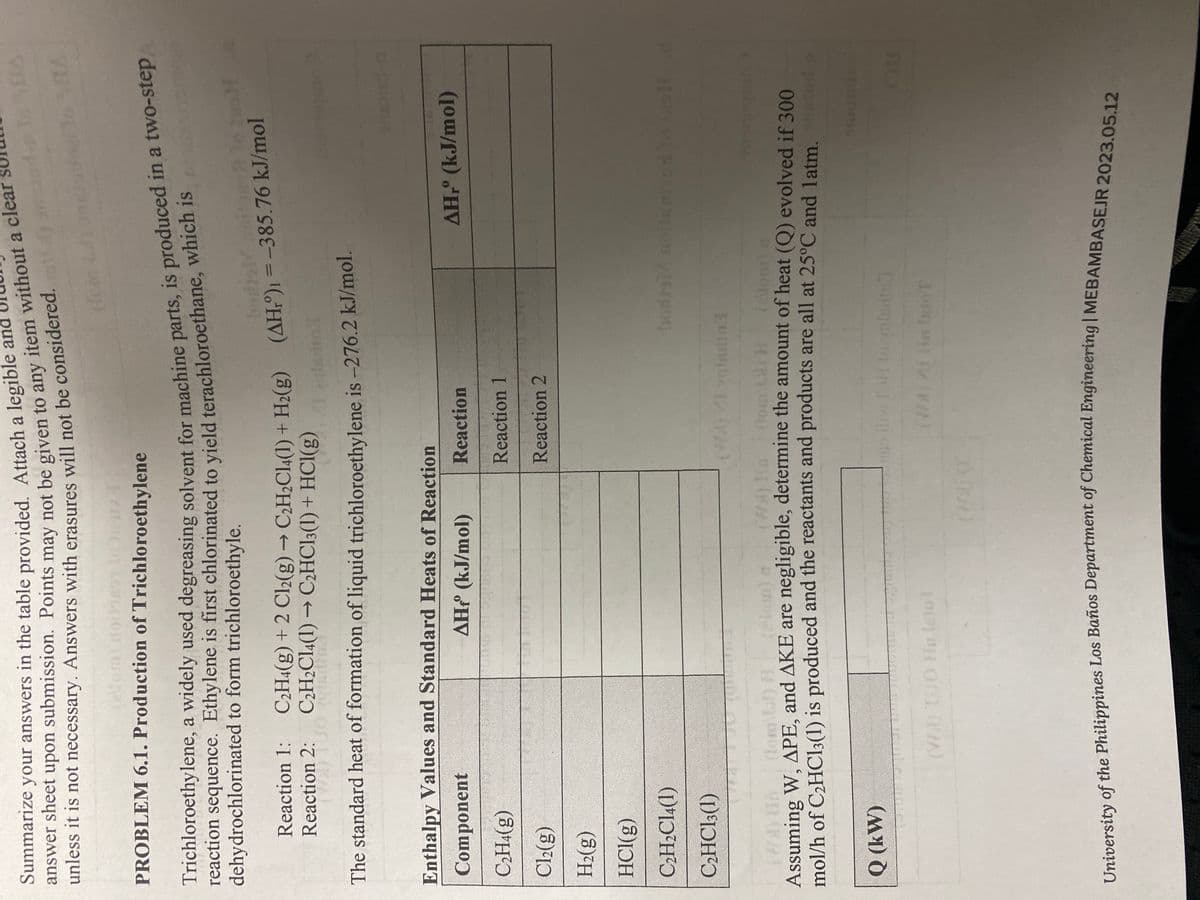answer sheet upon submission. Points may not be given to any item unless it is not necessary. Answers with erasures will not be considered.) sed PROBLEM 6.1. Production of Trichloroethylene Trichloroethylene, a widely used degreasing solvent for machine parts, is produced in a two-step reaction sequence. Ethylene is first chlorinated to yield terachloroethane, which is ope2 dehydrochlorinated to form trichloroethyle. Reaction 1: Reaction 2: C₂H4(g) + 2 Cl2(g) → C₂H₂C14(1) + H₂(g) C₂H2C14(1)→ C₂HCl3(1) + HCl(g) The standard heat of formation of liquid trichloroethylene is -276.2 kJ/mol. Enthalpy Values and Standard Heats of Reaction Component AH (kJ/mol) C₂H4(g) Cl₂(g) H₂(g) HCl(g) C₂H₂C14(1) C₂HC13(1) (AH)₁=-385.76 kJ/mol Reaction Reaction 1 Reaction 2 Q (kW) AH, (kJ/mol) (2 lom) Assuming W, APE, and AKE are negligible, determine the amount of heat (Q) evolved if 300 mol/h of C₂HC13(1) is produced and the reactants and products are all at 25°C and latm, d University of the Philippines Los Baños Department of Chemical Engineering | MEBAMBASEJR 2023.05.12
answer sheet upon submission. Points may not be given to any item unless it is not necessary. Answers with erasures will not be considered.) sed PROBLEM 6.1. Production of Trichloroethylene Trichloroethylene, a widely used degreasing solvent for machine parts, is produced in a two-step reaction sequence. Ethylene is first chlorinated to yield terachloroethane, which is ope2 dehydrochlorinated to form trichloroethyle. Reaction 1: Reaction 2: C₂H4(g) + 2 Cl2(g) → C₂H₂C14(1) + H₂(g) C₂H2C14(1)→ C₂HCl3(1) + HCl(g) The standard heat of formation of liquid trichloroethylene is -276.2 kJ/mol. Enthalpy Values and Standard Heats of Reaction Component AH (kJ/mol) C₂H4(g) Cl₂(g) H₂(g) HCl(g) C₂H₂C14(1) C₂HC13(1) (AH)₁=-385.76 kJ/mol Reaction Reaction 1 Reaction 2 Q (kW) AH, (kJ/mol) (2 lom) Assuming W, APE, and AKE are negligible, determine the amount of heat (Q) evolved if 300 mol/h of C₂HC13(1) is produced and the reactants and products are all at 25°C and latm, d University of the Philippines Los Baños Department of Chemical Engineering | MEBAMBASEJR 2023.05.12
Introduction to Chemical Engineering Thermodynamics
8th Edition
ISBN:9781259696527
Author:J.M. Smith Termodinamica en ingenieria quimica, Hendrick C Van Ness, Michael Abbott, Mark Swihart
Publisher:J.M. Smith Termodinamica en ingenieria quimica, Hendrick C Van Ness, Michael Abbott, Mark Swihart
Chapter1: Introduction
Section: Chapter Questions
Problem 1.1P
Related questions
Question

Transcribed Image Text:Summarize your answers in the table provided. Attach a legible and
answer sheet upon submission. Points may not be given to any item without a clea
unless it is not necessary. Answers with erasures will not be considered.
PROBLEM 6.1. Production of Trichloroethylene
Trichloroethylene, a widely used degreasing solvent for machine parts, is produced in a two-step
reaction sequence. Ethylene is first chlorinated to yield terachloroethane, which is
dehydrochlorinated to form trichloroethyle.
C₂H4(g) + 2 Cl2(g) → C₂H₂C14(1) + H₂(g) (AH)1=-385.76 kJ/mol
C₂H2C14(1)→ C2HCl3(1) + HCl(g)
gladins
The standard heat of formation of liquid trichloroethylene is -276.2 kJ/mol.
Reaction 1:
Reaction 2:
(W)
Enthalpy Values and Standard Heats of Reaction
Component
AH (kJ/mol)
C₂H4(g)
Cl₂(g)
H₂(g)
HCl(g)
C₂H₂C14(1)
C₂HCl3 (1)
Q (kW)
Reaction
Reaction 1
Reaction 2
(VD) TUO Hn lato T
(WA) veisdial
(lom\34) H
dom) a
Assuming W, APE, and AKE are negligible, determine the amount of heat (Q) evolved if 300
mol/h of C₂HCl3(1) is produced and the reactants and products are all at 25°C and 1 atm,
TOTE
ladin
off
AH,Ⓡ (kJ/mol)
bodro14 noitem104 to isoll d
(WA) / H Into T
RA
University of the Philippines Los Baños Department of Chemical Engineering | MEBAMBASEJR 2023.05.12
DI
Expert Solution
This question has been solved!
Explore an expertly crafted, step-by-step solution for a thorough understanding of key concepts.
This is a popular solution!
Trending now
This is a popular solution!
Step by step
Solved in 4 steps

Recommended textbooks for you

Introduction to Chemical Engineering Thermodynami…
Chemical Engineering
ISBN:
9781259696527
Author:
J.M. Smith Termodinamica en ingenieria quimica, Hendrick C Van Ness, Michael Abbott, Mark Swihart
Publisher:
McGraw-Hill Education

Elementary Principles of Chemical Processes, Bind…
Chemical Engineering
ISBN:
9781118431221
Author:
Richard M. Felder, Ronald W. Rousseau, Lisa G. Bullard
Publisher:
WILEY

Elements of Chemical Reaction Engineering (5th Ed…
Chemical Engineering
ISBN:
9780133887518
Author:
H. Scott Fogler
Publisher:
Prentice Hall

Introduction to Chemical Engineering Thermodynami…
Chemical Engineering
ISBN:
9781259696527
Author:
J.M. Smith Termodinamica en ingenieria quimica, Hendrick C Van Ness, Michael Abbott, Mark Swihart
Publisher:
McGraw-Hill Education

Elementary Principles of Chemical Processes, Bind…
Chemical Engineering
ISBN:
9781118431221
Author:
Richard M. Felder, Ronald W. Rousseau, Lisa G. Bullard
Publisher:
WILEY

Elements of Chemical Reaction Engineering (5th Ed…
Chemical Engineering
ISBN:
9780133887518
Author:
H. Scott Fogler
Publisher:
Prentice Hall


Industrial Plastics: Theory and Applications
Chemical Engineering
ISBN:
9781285061238
Author:
Lokensgard, Erik
Publisher:
Delmar Cengage Learning

Unit Operations of Chemical Engineering
Chemical Engineering
ISBN:
9780072848236
Author:
Warren McCabe, Julian C. Smith, Peter Harriott
Publisher:
McGraw-Hill Companies, The